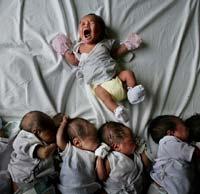Filipino babies born in Canada wrongly measured

Babies born in Ontario to mothers from the Philippines have significantly lower birth weights than those whose mothers were born in Canada or elsewhere in East Asia, and are twice as likely to be classified as small for their gestational age, a new study has found.
The classification is often incorrect, researchers say, because the babies are being compared to those of other ethnic backgrounds. When compared to other Filipino babies, they are well within appropriate heights and weights.
The lead author of the study, published online in the Journal of Obstetrics and Gynaecology Canada, is Leanne De Souza, a PhD candidate working with Dr. Joel Ray, an obstetrical medicine physician at St. Michael’s Hospital. Dr. Ray and his colleagues previously developed the first “newborn weight curves” for specific ethnic groups across Canada.
Birthweight curves are graphs used to plot how one baby’s weight compares to others of the same age.
A baby whose birthweight is below the lowest tenth percentile of the curve is deemed to be “small for gestational age” or SGA. These babies may be at higher risk for developmental issues, lower cognitive functions, short stature and even death.
In developing the customized weight curves, they found that babies born to mothers from each region of the world, except Europe and other Western countries, had significantly lower birthweights than those for infants of Canadian-born mothers.
This study looks specifically at babies of mothers born in one Asian country, the Philippines. East Asians are the fastest-growing immigrant group in Canada and those from the Philippines form the second-largest subgroup of these immigrants.
The study used Vital Statistics records of 548,418 singleton births in Ontario between 2002 and 2007, including more than 15,000 babies born to mothers from the Philippines.
They found about nine in every 100 male newborns of mothers from the Philippines were misclassified as being small for gestational age using conventional weight curves, a number even higher than that for East Asian males, whose degree of misclassification was six per 100.
De Souza said it was important to accurately measure newborns to ensure they receive the proper care and to avoid unnecessary and often costly monitoring and treatment.
She said recent research on Filipino child health suggests they have a higher risk than other East Asians not just of being labeled small for gestational age, but also of being born prematurely or stillborn. Filipino children have the highest rates of being underweight and of small stature compared with other East Asians and Pacific Island groups.
St. Michael’s Hospital founded in 1892, is fully affiliated with the University of Toronto.
Leave a comment






